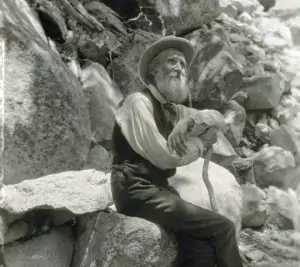 This article [John Muir’s Literary Science] was originally published in The Public Domain Review [https://publicdomainreview.org/2011/06/09/john-muirs-literary-science/] under a Creative Commons Attribution-ShareAlike 3.0. If you wish to reuse it please see: http://publicdomainreview.org/legal/
This article [John Muir’s Literary Science] was originally published in The Public Domain Review [https://publicdomainreview.org/2011/06/09/john-muirs-literary-science/] under a Creative Commons Attribution-ShareAlike 3.0. If you wish to reuse it please see: http://publicdomainreview.org/legal/

✅ AI Essay Writer ✅ AI Detector ✅ Plagchecker ✅ Paraphraser
✅ Summarizer ✅ Citation Generator
By Terry Gifford
John Muir was not unaware of how his discoveries from his empirical research in Yosemite were being used by the professionals who were impatient for conventional scientific papers from him. Muir suspected that his refusal of scientific discourse initially left him vulnerable. Muir’s early revolutionary newspaper article titled “Living Glaciers of California” began life in a letter of 8 October 1872 to his friend Jeanne Carr in which Muir set out his empirical research results in glaciology, joking, “You will have the first chance to steal.” This follows his complaint that a paper for the Boston Society of Natural History from Professor Samuel Kneeland drew from Muir’s work “and gave me credit for all of the smaller sayings and doings, and stole the broadest truth to himself.” When Muir’s literary executor William Frederic Badè compiled “The Life and Letters” (1924; reprinted 1996) he tactfully omitted a paragraph from this letter in which Muir also wondered how much credit he was being given in a lecture by the Berkeley geologist Professor LeConte whom Muir had guided with his students in Yosemite two years before. This lecture was to be published and was advertised as ‘advancing many new and interesting theories.’ Muir wrote to Jeanne Carr that he could better express his own thoughts for the public than LeConte’s “second-hand rehash.” So Muir’s resolve to publish his own work more effectively, using Jeanne Carr as, in effect, his literary agent, derived, at least in part, from a mistrust of professional scientists. In his determined amateurism and refusal to limit himself to the discourse of the professionals, Muir reached a wider audience with greater effect, gaining for himself a place not only in scientific, but also in literary history. In the richness of Muir’s discourse, he reveals himself to be what he admired in Asa Gray, “a great, progressive, unlimited man like Darwin and Huxley and Tyndall.”
What are the ways in which Muir’s discourse might be described as “progressive” and “unlimited?” Two key features are narrative and metaphor. Even as he prepared to give the facts and figures of the movements of his stakes in the Mt. McClure glacier, which proved that the living glaciers of the high Sierra were moving at one inch each day, Muir launched into a mystery narrative, vivid with detail, lively in analogy, seductive in alliteration and powerfully rhythmic:
One of the yellow days of last October, when I was among the mountains of the Merced group, following the footprints of the ancient glaciers that once flowed grandly from their ample fountains, reading what I could of their history as written in moraines and canyons and lakes and carved rocks, I came upon a small stream that was carrying mud I had not before seen.
Ending this sentence with a slightly formal inversion enables Muir to produce the rhyme that sets up the mystery: “stream’/’seen.”
In his personal narratives, Muir frequently exclaims aloud: “Before I had time to reason I said, “Glacier Mud! Mountain meal!”’ The dramatic effect of this on the page has been enhanced by Badè’s addition of the quotation and exclamation marks. It is worth remembering that Muir developed a reputation for oral dramatic storytelling that must have been symbiotic with his written narrative sense. Ronald Limbaugh has brilliantly shown that Muir integrated not only his reading, but his oral storytelling with what we have in print in the case of the story of Stickeen. So, as the narrative unfolds, mud leads to a terminal moraine, above which is snow, on which are lines of stones clearly moving in curves and “I shouted, “A living glacier!”’ The Berkeley scientist LeConte had mistrusted Muir’s sample of glacier ice that he had sent him years before, so Muir ‘determined to collect proofs of the common measured arithmetical kind’ which in this letter/article/paper he goes on provide. Of course, what Muir’s measurements revealed was a narrative much more important than that of personal discovery, solving a mystery, or correcting the skeptical professionals of his day who clung to a belief that Yosemite Valley was formed by a single seismic cataclysm. Muir’s is the fundamental narrative demonstrated from different data by Darwin, that creation is still ongoing.
It is the dynamic interplay of elemental forces in the natural world that is Muir’s central narrative, and the reason why his writing is so dramatic is because he seeks to place himself in their way for the purpose not only of empirical observation, but also to be at home in them as a species. Muir’s scientific data is always a personal narrative because he wants to demonstrate that it is possible for our species to find a place in that ongoing creation. His personal example leads his readership to be aware of choices crucial to its influence on evolution. If, for example, logging reduced the number of tree species in America, the future evolution of American forests was limited in its development. Conservation became, for Muir, not just nostalgic preservation, but an intervention in potential futures. In specific cases, this narrative would determine whether the human species could survive in America. Muir noted that the logging of watersheds, for example, was having a disastrous effect upon water conservation in a California that looked unlikely to be able to sustain its growing human population.
Commenting on Darwin’s evolutionary narrative, Gillian Beer writes, “Evolutionary theory brings together two imaginative elements implicit in much nineteenth-century thinking and creativity. One was the fascination with growth … The other was the concept of transformation.” When Beer writes that the reason why Wordsworth and Coleridge mattered to Darwin was because of their “emphasis on growth and process rather than on conclusion and confirmation,” one recognizes Muir’s central narrative drive. For Muir, that unfinished process of American nature—rather than American “landscapes”—had implications for the human species that called for a conservation debate that went deeper than the usual nineteenth century American concept of “wise use of resources.” This required a popular mode of writing that could draw upon all the resources of rhetoric. As a trained scientist who had studied the Bible, Milton and Burns, Muir had the literary skills as well as the discipline-base to combine the discourses of authoritative scientist, popular poetic nature writer, and conservationist preacher with, admittedly, varying degrees of success.
Unlike Darwin, it is clear that Muir delighted in his rhetorical resources. “Despite the metaphoric density of his writing,” Beer writes, “Darwin seems never to have raised into consciousness its imaginative … implications … He saw some of the dangers of “authorisation.”’ Muir reveled in “authorization,” playfully and brilliantly mixing his metaphors with startling effects. One of the techniques Muir frequently used to generate the awe of looking at something afresh was the analogy of poetic images. Thus, we have in the discourse of the Studies in the Sierra (1874; reprinted in Gifford 1996) “ice-ploughs,” “glacial cultivation,” “ice-wombs, now mostly barren,” “pages of rocks embellished with gardens,” a “canyon-tree” of ice whose “fruit and foliage” are “meadow and lake,” together with a “five-petaled glacier.” In her study of Victorian scientific prose, Gillian Beer notes the use of poetic effects: “Poetry offered particular formal resources to think with … The poet sets up multiple relations between ideas in a style closer to the form of theorems than of prose. It is clear that Muir was thinking with his metaphors, as when he wrote that whilst the tree analogy for a river served some aspects well, in other respects they ‘more nearly resemble certain gigantic algae with naked stalks.” The essay on the “Formation of Soils” concludes with Muir’s all-encompassing proto-ecological vision that all his poetic devices try to serve: “Nor in all these involved operations may we detect the faintest note of disorder; every soil-atom seems to yield enthusiastic obedience to law—boulders and mud-grains moving to music as harmoniously as the far-whirling planets.” The scope of this, as well as its biblical construction and rhythms, conveys a subtle spiritual dimension that is inherent rather than explicit. But later in life, faced with the urgent need for conservation campaigning, based upon his then extensive scientific knowledge, Muir was also to be roused to the ranting discourse of the preacher.
“Dam Hetch Hetchy! As well as dam for water-tanks the people’s cathedrals and churches, for no holier temple has ever been consecrated by the heart of man.” Muir could work his rhetoric up to end a book with a bang. “God has cared for these trees, saved them from drought disease, avalanches and a thousand straining leveling tempests and floods; but he cannot save them from fools—only Uncle Sam can do that.” The final arguments of The Yosemite and Our National Parks respectively are not Muir’s strongest, despite their strong form of discourse. Both arguments appear to appeal to the religious norms of his readers, but both are flawed by their own internal logic. If human-made temples are not as holy as Hetch Hetchy Valley, they might provide better water-tanks. And no post-Darwinian proto-ecologist can believe that ‘God’ has ‘saved’ America’s forests. In fact, the rather more measured discourse that has preceded these resounding final rants is more convincing.
On the Hetch Hetchy issue, Muir took each of the popular arguments for flooding the valley and corrected false information and impressions. Muir argued that this valley is “one of the greatest of all our natural resources for the uplifting joy and peace and health of the people … where Nature may heal and cheer and give strength to body and soul alike.” The argument for the healing power of direct contact with wild nature for urban humans appealed to both utility and spirituality. In his later writing, Muir’s democratic appeal on behalf of “the people” was the basis for his conservation strategy. As himself an immigrant with an immigrant’s faith in American democracy, Muir made a moving argument at the end of Our National Parks about America’s welcoming those to the woods who would live wisely in them, but that regulation for sustainable living must ultimately be made by the federal government to control corporate lumber interests. So ultimately, it is not just that Muir could not confine himself to the discourse of the empirical scientist, could not deny his poetic muse. Muir’s talent as a popular writer reaching a wide audience throughout America was put at the service of the American land through the medium of the voting power of the American people.
Of course, some of Muir’s writing can seem excruciatingly New Age to the contemporary reader unsympathetic to this discourse, as in the most sentimental of Muir’s personifications when, returning from days spent on the glaciers, “bird and plant friends” welcomed him back among them. It is worth noting Gillian Beer’s observation that Darwin’s anthropomorphisms were “based on the assumed congruity of man with all other forms of life.” It is fair to recognize that Muir’s eccentric whimsical persona produced these effects partly out of the same mode of discourse that allowed for “snowflowers” and “petaled glaciers.” Images that reminded readers of the seamless nature of the processes of growth and decay, of the sensitivity of everything to its context, were key features of Muir’s rhetorical strategy. We may now wince ourselves to read in the Studies that “the huge granite valley was lithe as a serpent, and winced tenderly to the touch of every tributary.” But here was a work of science that sought to convey a vision of more than just “congruity” that strains at the limits of the resources of human discourses themselves.
Muir’s earliest published journal, A Thousand Mile Walk to the Gulf, is probably his earliest sustained prose attempt to find a discourse adequate to his sense of the dimensions of the world to which he was so alert. This journal is a young man’s purging of many of the assumptions with which he has grown up. It is both a humbling and an uplifting experience: “The substance of the winds is too thin for human eyes, their written language is too difficult for human minds, and their spoken language mostly too faint for the ears.” But for Muir, the demand for a rich use of multiple discourses that not only integrate our forms of knowledge but our modes of expression, is produced by the attempt to confront the complexity of the world in which we have to be at home or die. Muir’s early frustration at the limits of human discourse arose out of a deep sense of the richness of relations in the natural world he wanted to mediate. In that early journal, Muir wrote: “There is not a fragment in nature, for every relative fragment of one thing is a full harmonious unit in itself. All together form the one great palimpsest of the world.” Only a literature such as Muir developed, that drew from all the multiple modes of discourse available, could hope to see into and serve that palimpsest.
Follow us on Reddit for more insights and updates.





Comments (0)
Welcome to A*Help comments!
We’re all about debate and discussion at A*Help.
We value the diverse opinions of users, so you may find points of view that you don’t agree with. And that’s cool. However, there are certain things we’re not OK with: attempts to manipulate our data in any way, for example, or the posting of discriminative, offensive, hateful, or disparaging material.